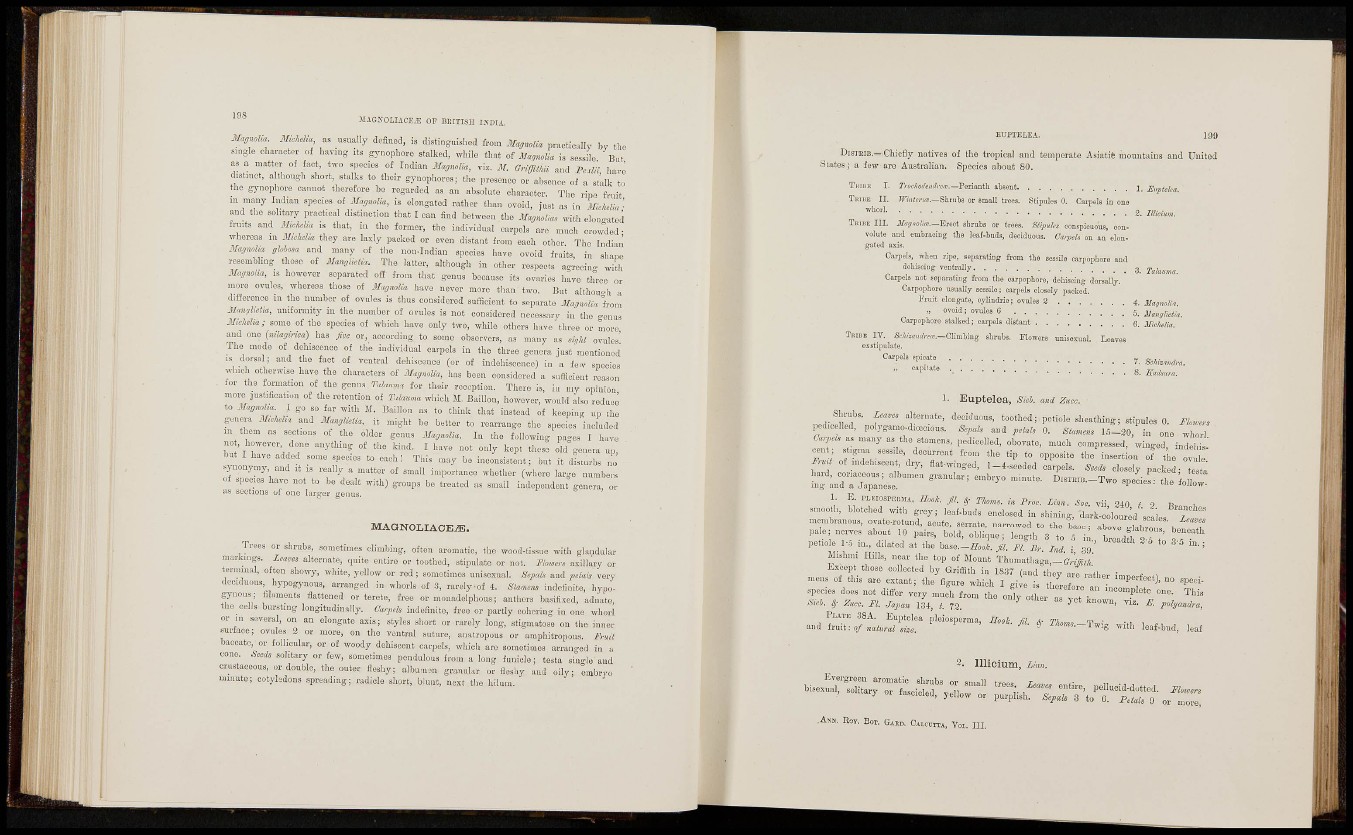
I9S îliGXOLIACIJE OF BlilTISII ODU.
MkMÚ. ^ „»ally defined, is distinguished from Ma,noUa praoliojly by ths
singla chaviiotet of having its gynophore stolkod, wllilo that of Hagnolia. is sessile Bnt
as a matter of fact, two species of Indian Magnolia, viz. M. GriUUMi and P „SÏ have
distmct, a though short, stalks to thcii- gynoplio.-es; the presence or absence of a stalk to
the gynophore cannot therefore be regarded as an absolute eh.racter. The rioe fruit
m many Indian speeies of liagmlk, is elongated rather than oroid, jnst as in MkUia
and the solitary jn-actieal distinction that I oan ünd between the „i t h elongated
fruits and is that, iu the former, the individual earpels are much eiwdod
whereas in M d « they are laxly packed or even distant from each other. The India,
M,ujmM sMo» and many of tho non-Indian species I,ave ovoid fruits, in shape
resemblmg those of iMavlMia. Tho latter, although in other respects acrreeino- wid,
llagnoHa u hoover separated off from that genus because its ovaries have three or
more ovules, whereas those of MagmU, have never more than two. But aithou.H, a
diflerenee n, the number of ovules is thus considered sufficient to separate from
M«n,bdh, uniformity in the number of ovules is not considered necessary in the genus
Michdm; some of the species of which have only two, while others have three or more
and one («¡lagirim) has f x or, according to some observers, as many as d,,U ovules'
The mode of dehiscence of the individual caipcls in the three geno™ just mentioned
IS dorsal; and the fact of ventral deiiiscence (or of iudehiscence) iu a few species
which otherwise have the characters of Magnolm, has been considered a sufficient reason
for the formation of the genns TaUmm for their reception. There is, in my opinion
more justification of the retention of T.Uaa,m which M. Bâillon, however, would also reduce
to Magmh^. .1 go so far with JI. Bâillon a, to thiiili that instead of keeping up tho
genera Miahdvi and Mmglisim, it might be better to rearrange tlic species included
in them as sections of the older genus Magw,lm. In the following- pactes I have
no , however done anything of the kind. I have net only kept these oId°gcuera up,
but I have added some species to each! This may be inconsistent; but it dliaibs „„
sjmonymy and it is really a matter of small importance whether (where lai-„e numbers
of spocies have not to be dealt with) groups be treated as small independent genera, or
as sections of one larger genus.
M A G N O L I A O B ^ .
Trees or shrubs, sometimes climbing, often aromatic, the wood-tissue with glandular
markings. Lave, alternate, qmto entire or toothed, stipulate or not. Moim, axillary or
termmal, often showy, white, yellow or red ; sometimes unisexual. Sefak and f,ta,is very
deciduous, hypogynons, arranged in whorls of 3, rarelyof 4. Sto««» indefinite, hypogynous;
filaments flattened or terete, free or monadelphous ; anthers basifi.ed, adnate
the cells bursting longitudinally. Oar,»b indefinite, free or jjartly ccherin.> in one whorl
or in several, on an elongate axis; styles short or rarely long, stigin.tose on the inner
surface; ovules 2 or more, on the ventral suture, anatropous or amphitrepoiis. F„it
baccate, or follicular, or of woody dehiscent carpols, which are sometimes arran.red in a
cone. solitary or few, sometimes pendulous froa, a long funicle; testa sin»-le and
crastaceous, or double, the outer fleshy; albumen granular or fleshy and oily; embrvo '
minute; cotyledons spreading; radicle short, blunt, next the hilum.
ETJPTELEA. 19 0
DISTEIB.—Chiefly natives of the tropical and temperate Asiatife mountains and United
States; a few are Australian. Species about 80.
TKIUE I. Perianth absent Ei^iUha.
TNNIE II. TTi/iíeriíB.—Shnihs or small trees. Stipules 0. Cai-pels in one
raa»».
THIUE HI. Erect slirubs or trees. Btip'^ks eou.spiouous, convolute
aud embracing the leaf-buds, deciduous. Cai-jieh on an elongated
asís.
Carpels, when ripe, separating from the sessilo carpophore and
deiiseiog veatrally
tarpele not sepaiatuig from the carpophore, dehiscing dorsally.
Carpophore usually sessile; earpels closely paolied.
Ji'ruit elongate, oyliadrie; orales 2 4 Magmlia
,, ovoid; ovale, 6 >,. U.n¡li.Ua.
Carpophore stalked; carpels distant Mie/t^Hii.
TaiBE IV, ScAíMiirfrí«,.—Climbing ahrahs. Flowers unisesaal. Leaves
esstipalate.
Carpel, .pieale 7. &i,Wr«.
,, oapilate
1- Euptelea, S A aud Zaec.
Shi-ubs. Lc„a alternate, deciduous, teethed; petiole sheathing; stipules 0, Ä«,-.
ped,colled, polygamo-dnecious. S.pak and yrfafe 0. 15 - 3 0 , in one T o r
Carp.I, as many as the stamens, pediceUed, obovate, much compressed, winged indehi,'
c^ent; stigma sess.le, decurrent from the tip to opposite the insertion o? the ovn '
Fru. of mdeh,scent dry, flat-wiiigod, l-4.seeded carpels. Seei. closely packed- Testa
• I G L — ^ E S ? " " " -
I. E. pmaospmHi, ffaoi. ß . ^
smooth, blotched with grey; leaf-buds euch,sed in shining, d a r k - »Wd scai„s 7 "
inembranons, ovate-rotund, acuto, serrate, narrowed to the base; aWe " l a b ™ T
pale; nerves about 10 pairs, bold, oblique; length 3 to 5 in bldfh 2Tt
Jietieie 1-e in„ dilated at the b a s e . - M . ßl. FL Hr m i 39 ' ^ ® '
Misbini Hills, near the top of Mount Thumathaga,-»,.;®/,'
Itxcept those collected by Griffith in 1837 (and tlipv mi^
mens of this are extant; the figure which I giio is horefl » • "-¡"cispecies
does net differ very mnch from the only o t L as ° t •
Si,l. ^ Z„cc. FL Japan 134, i. 72. ^ polyandra,
^ » - T w i g with leaf-bud, leaf
2. Illicium, Linn.
.Am. Ee,. Bor. SiED. CiEcutr.i, Vor. m .